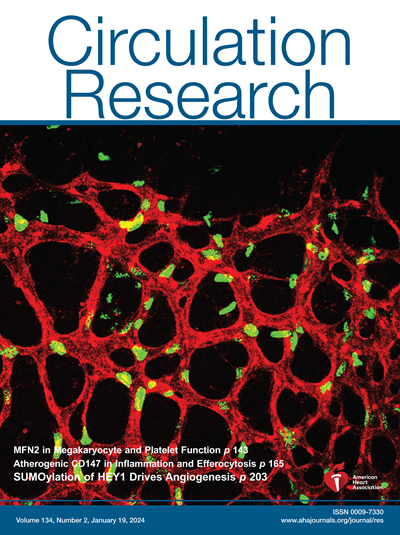Circulating Immune Cell Signature Analysis in HFpEF Across Species.
IF 16.2
1区 医学
Q1 CARDIAC & CARDIOVASCULAR SYSTEMS
引用次数: 0
Abstract
BACKGROUND Heart failure with preserved ejection fraction (HFpEF) is a heterogeneous clinical picture that is closely related to extracardiac comorbidities such as obesity, hypertension, and diabetes and is associated with chronic, low-grade systemic inflammation. Previous studies on myocardial biopsies of patients with HFpEF showed intramyocardial inflammatory activity, suggesting that the inflammatory processes in HFpEF are predominantly systemic and exhibit compartment-specific patterns. METHODS We performed single-cell RNA sequencing of peripheral blood mononuclear cells of patients with HFpEF (n=6), heart failure with reduced ejection fraction patients (n=8), and healthy controls (n=7), taking obesity status into account. For validation, bulk RNA sequencing was performed on whole blood samples. In parallel, the systemic immune cell response was investigated in an HFpEF mouse model (induced by a high-fat diet plus L-NAME), with one group additionally administered the anti-inflammatory agent nitro-oleic acid. RESULTS Analysis of human peripheral blood mononuclear cells revealed an HFpEF-specific inflammatory fingerprint, which manifested in obesity-related increased expression of cytokine signaling genes (eg, CCL2 and TNF) and obesity-independent increases in mitochondrial-associated activity. In the mouse model, HFpEF animals showed a comparable increase in inflammatory markers, with treatment with nitro-oleic acid leading to a partial normalization of immunologic signatures and a significant improvement in diastolic function. CONCLUSIONS Our results demonstrate that the immune cells of patients with HFpEF are characterized by a distinct transcriptional immune signature that differs from that of patients with heart failure with reduced ejection fraction analyzed in this study. The conserved immunologic signatures between the human and murine data sets analyzed here, and the beneficial effect of nitro-oleic acid in the preclinical model induced by high-fat diet and L-NAME, provide translational insights and generate hypotheses for personalized interventions in HFpEF.跨物种HFpEF循环免疫细胞特征分析。
背景:保留射血分数的心力衰竭(HFpEF)是一种异质性的临床表现,与心外合并症(如肥胖、高血压和糖尿病)密切相关,并与慢性、低度全身炎症相关。先前对HFpEF患者心肌活检的研究显示心肌内炎症活动,表明HFpEF的炎症过程主要是全身性的,并表现出室特异性模式。方法考虑肥胖状况,我们对HFpEF患者(n=6)、心力衰竭伴射血分数降低患者(n=8)和健康对照(n=7)的外周血单个核细胞进行了单细胞RNA测序。为了验证,对全血样本进行了大量RNA测序。同时,在高脂饮食加L-NAME诱导的HFpEF小鼠模型中,研究了全身免疫细胞反应,其中一组额外给予抗炎剂硝基油酸。结果对人外周血单个核细胞的分析显示hfpef特异性炎症指纹图谱,表现为肥胖相关的细胞因子信号基因(如CCL2和TNF)表达增加以及肥胖无关的线粒体相关活性增加。在小鼠模型中,HFpEF动物显示炎症标志物的相应增加,用硝基油酸治疗导致免疫特征部分正常化和舒张功能的显着改善。结论HFpEF患者的免疫细胞具有明显的转录免疫特征,这与本研究中分析的心力衰竭伴射血分数降低患者的免疫特征不同。本文分析的人类和小鼠数据集之间的保守免疫特征,以及硝基油酸在高脂肪饮食和L-NAME诱导的临床前模型中的有益作用,为HFpEF的个性化干预提供了翻译见解和假设。
本文章由计算机程序翻译,如有差异,请以英文原文为准。
求助全文
约1分钟内获得全文
求助全文
来源期刊

Circulation research
医学-外周血管病
CiteScore
29.60
自引率
2.00%
发文量
535
审稿时长
3-6 weeks
期刊介绍:
Circulation Research is a peer-reviewed journal that serves as a forum for the highest quality research in basic cardiovascular biology. The journal publishes studies that utilize state-of-the-art approaches to investigate mechanisms of human disease, as well as translational and clinical research that provide fundamental insights into the basis of disease and the mechanism of therapies.
Circulation Research has a broad audience that includes clinical and academic cardiologists, basic cardiovascular scientists, physiologists, cellular and molecular biologists, and cardiovascular pharmacologists. The journal aims to advance the understanding of cardiovascular biology and disease by disseminating cutting-edge research to these diverse communities.
In terms of indexing, Circulation Research is included in several prominent scientific databases, including BIOSIS, CAB Abstracts, Chemical Abstracts, Current Contents, EMBASE, and MEDLINE. This ensures that the journal's articles are easily discoverable and accessible to researchers in the field.
Overall, Circulation Research is a reputable publication that attracts high-quality research and provides a platform for the dissemination of important findings in basic cardiovascular biology and its translational and clinical applications.
 求助内容:
求助内容: 应助结果提醒方式:
应助结果提醒方式:


